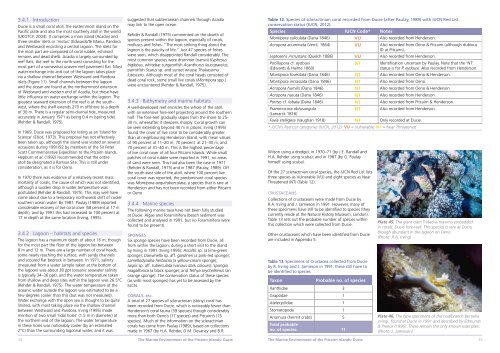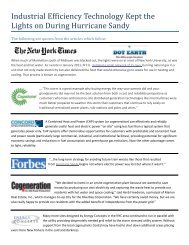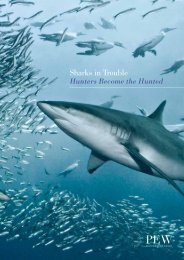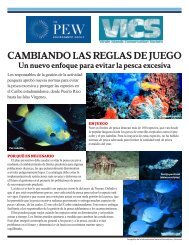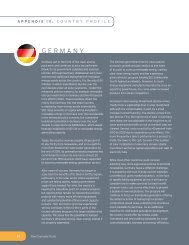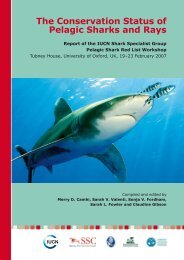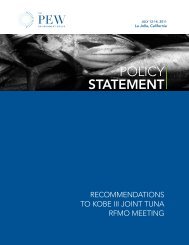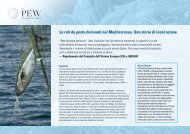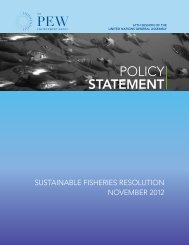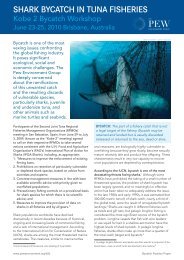The Marine Environment of the Pitcairn Islands - Pew Environment ...
The Marine Environment of the Pitcairn Islands - Pew Environment ...
The Marine Environment of the Pitcairn Islands - Pew Environment ...
You also want an ePaper? Increase the reach of your titles
YUMPU automatically turns print PDFs into web optimized ePapers that Google loves.
3.4.1 Introduction<br />
Ducie is a small coral atoll, <strong>the</strong> easternmost island on <strong>the</strong><br />
Pacific plate and also <strong>the</strong> most sou<strong>the</strong>rly atoll in <strong>the</strong> world<br />
(UKOTCF, 2004). It comprises a main island (Acadia) and<br />
three smaller islets or ‘motus’ (Edwards/Te Manu, Pandora<br />
and Westward) encircling a central lagoon. <strong>The</strong> islets for<br />
<strong>the</strong> most part are composed <strong>of</strong> coral rubble, echinoid<br />
remains and dead shells. Acadia is largely surrounded by<br />
reef flats, <strong>the</strong> reef to <strong>the</strong> north-west consisting for <strong>the</strong><br />
most part <strong>of</strong> a somewhat uneven reef pavement flat. Most<br />
water exchange into and out <strong>of</strong> <strong>the</strong> lagoon takes place<br />
via a shallow channel between Westward and Pandora<br />
islets (Figure 11). Small channels between <strong>the</strong> lagoon<br />
and <strong>the</strong> ocean are found at <strong>the</strong> nor<strong>the</strong>rnmost extension<br />
<strong>of</strong> Westward and western end <strong>of</strong> Acadia, but <strong>the</strong>se have<br />
little influence on water exchange within <strong>the</strong> lagoon. <strong>The</strong><br />
greatest seaward extension <strong>of</strong> <strong>the</strong> reef is at <strong>the</strong> southwest,<br />
where <strong>the</strong> shelf extends 270 m <strong>of</strong>fshore to a depth<br />
<strong>of</strong> 30 m. <strong>The</strong>re is a regular semi-diurnal tide, measured<br />
accurately in January 1971 as being 0.4 m (spring tide)<br />
(Rehder & Randall, 1975).<br />
In 1969, Ducie was proposed for listing as an ‘Island for<br />
Science’ (Elliot, 1973). This proposal has not effectively<br />
been taken up, although <strong>the</strong> island was visited on several<br />
occasions during 1991/92 by members <strong>of</strong> <strong>the</strong> Sir Peter<br />
Scott Commemorative Expedition to <strong>the</strong> <strong>Pitcairn</strong> <strong>Islands</strong>.<br />
Hepburn et al. (1992) recommended that <strong>the</strong> entire<br />
atoll be designated a Ramsar Site. This is still under<br />
consideration, as it is for Oeno.<br />
In 1970 <strong>the</strong>re was evidence <strong>of</strong> a relatively recent mass<br />
mortality <strong>of</strong> corals, <strong>the</strong> cause <strong>of</strong> which was not identified,<br />
although a sudden drop in water temperature was<br />
postulated (Rehder & Randall, 1975). This may well have<br />
come about due to a temporary northwards shift <strong>of</strong> cooler<br />
sou<strong>the</strong>rn ocean water. By 1987, Paulay (1989) reported<br />
considerable recovery <strong>of</strong> live coral cover (58 percent at 17 m<br />
depth), and by 1991 this had increased to 100 percent at<br />
17 m depth at <strong>the</strong> same location (Irving, 1995).<br />
3.4.2 Lagoon – habitats and species<br />
<strong>The</strong> lagoon has a maximum depth <strong>of</strong> about 16 m, though<br />
for <strong>the</strong> most part <strong>the</strong> floor <strong>of</strong> <strong>the</strong> lagoon lies between<br />
8 m and 12 m. <strong>The</strong>re are a large number <strong>of</strong> coral heads,<br />
some nearly reaching <strong>the</strong> surface, with sandy channels<br />
and scoured flat bedrock in between. In 1971, salinity<br />
(measured from a water sample taken at <strong>the</strong> bottom <strong>of</strong><br />
<strong>the</strong> lagoon) was about 38 ppt (oceanic seawater salinity<br />
is typically 34–36 ppt), and <strong>the</strong> water temperature taken<br />
from shallow and deep sites within <strong>the</strong> lagoon was 26.5°C<br />
(Rehder & Randall, 1975). <strong>The</strong> water temperature <strong>of</strong> <strong>the</strong><br />
oceanic water outside <strong>the</strong> lagoon was estimated to be a<br />
few degrees cooler than this (but was not measured).<br />
Water exchange with <strong>the</strong> open sea is thought to be quite<br />
limited, with most taking place via <strong>the</strong> shallow channel<br />
between Westward and Pandora. Irving (1995) made<br />
mention <strong>of</strong> two small ‘tidal holes’ (1.5 m in diameter) at<br />
<strong>the</strong> nor<strong>the</strong>rn end <strong>of</strong> <strong>the</strong> lagoon. <strong>The</strong> water temperature<br />
in <strong>the</strong>se holes was noticeably cooler (by an estimated<br />
2°C) than <strong>the</strong> surrounding lagoonal water, and it was<br />
suggested that subterranean channels through Acadia<br />
may link to <strong>the</strong> open ocean.<br />
Rehder & Randall (1975) commented on <strong>the</strong> dearth <strong>of</strong><br />
species present within <strong>the</strong> lagoon, especially <strong>of</strong> corals,<br />
molluscs and fishes: “<strong>The</strong> most striking thing about <strong>the</strong><br />
lagoon is <strong>the</strong> paucity <strong>of</strong> life.” Just 47 species <strong>of</strong> fishes<br />
were seen, which disappointed Randall considerably. <strong>The</strong><br />
most common species were drummer (nanwi) Kyphosus<br />
bigibbus, whitebar surgeonfish Acanthurus leucopareius,<br />
parrotfish Scarus sp. and sunset wrasse Thalassoma<br />
lutescens. Although most <strong>of</strong> <strong>the</strong> coral heads consisted <strong>of</strong><br />
dead coral rock, some small live corals (Montipora spp.)<br />
were encountered (Rehder & Randall, 1975).<br />
3.4.3 Bathymetry and marine habitats<br />
A well-developed reef encircles <strong>the</strong> whole <strong>of</strong> <strong>the</strong> atoll,<br />
with an extensive fore-reef projecting around <strong>the</strong> sou<strong>the</strong>rn<br />
half. <strong>The</strong> fore-reef gradually slopes from <strong>the</strong> shore to 25-<br />
30 m, whereafter it steepens sharply. Coral growth can<br />
be seen extending beyond 40 m in places. Irving (1995)<br />
found <strong>the</strong> cover <strong>of</strong> live coral to be considerably greater<br />
than at neighbouring Henderson Island, with mean values<br />
<strong>of</strong> 90 percent at 11–20 m, 70 percent at 21–30 m, and<br />
70 percent at 31–40 m. This is <strong>the</strong> highest percentage<br />
<strong>of</strong> live coral cover <strong>of</strong> all four <strong>Pitcairn</strong> <strong>Islands</strong>. While small<br />
patches <strong>of</strong> coral rubble were reported in 1991, no areas<br />
<strong>of</strong> sand were seen. This had also been <strong>the</strong> case in 1971<br />
(Rehder & Randall, 1975) and in 1987 (Paulay, 1989). Off<br />
<strong>the</strong> south-east side <strong>of</strong> <strong>the</strong> atoll, where 100 percent live<br />
coral cover was reported, <strong>the</strong> predominant coral species<br />
was Montipora aequituberculata, a species that is rare at<br />
Henderson and has not been recorded from ei<strong>the</strong>r <strong>Pitcairn</strong><br />
or Oeno.<br />
3.4.4 <strong>Marine</strong> species<br />
<strong>The</strong> following marine taxa have not been fully studied<br />
at Ducie: Algae and Foraminifera (beach sediment was<br />
collected and analysed in 1991, but no Foraminifera were<br />
found to be present).<br />
SPONGES<br />
Six sponge species have been recorded from Ducie, all<br />
from within <strong>the</strong> lagoon, during a short visit to <strong>the</strong> island<br />
by Irving in 1991 (Irving 1995): Ascaltis sp. (a lime-green<br />
sponge); Darwinella sp. aff. gardineri (a pink-red sponge);<br />
Lamellodysidea herbacea (a yellow-cream sponge);<br />
Jaspis sp. aff. tuberculata (various dark colours); Spongia<br />
magallonica (a black sponge); and Tethya seychellensis (an<br />
orange sponge). <strong>The</strong> conservation status <strong>of</strong> <strong>the</strong>se species<br />
(as with most sponges) has yet to be assessed by <strong>the</strong><br />
IUCN.<br />
CORALS, etc.<br />
A total <strong>of</strong> 27 species <strong>of</strong> scleractinian (stony) coral has<br />
been recorded from Ducie, which is noticeably fewer than<br />
Henderson’s coral fauna (59 species) though considerably<br />
more than both Oeno’s (17 species) and <strong>Pitcairn</strong>’s (15<br />
species). Much <strong>of</strong> <strong>the</strong> information on <strong>the</strong> scleractinian<br />
corals has come from Paulay (1989), based on collections<br />
made in 1967 (by H.A. Rehder, D.M. Devaney and B.R.<br />
Wilson using a dredge); in 1970–71 (by J.E. Randall and<br />
H.A. Rehder using scuba); and in 1987 (by G. Paulay<br />
himself using scuba).<br />
Of <strong>the</strong> 27 scleractinian coral species, <strong>the</strong> IUCN Red List lists<br />
three species as Vulnerable (VU) and eight species as Near<br />
Threatened (NT) (Table 12).<br />
CRUSTACEANS<br />
Collections <strong>of</strong> crustaceans were made from Ducie by<br />
R.A. Irving and J. Jamieson in 1991. However, many <strong>of</strong><br />
<strong>the</strong>se specimens have still to be identified to species (<strong>the</strong>y<br />
currently reside at <strong>the</strong> Natural History Museum, London).<br />
Table 13 sets out <strong>the</strong> probable number <strong>of</strong> species within<br />
this collection which were collected from Ducie.<br />
O<strong>the</strong>r crustaceans which have been identified from Ducie<br />
are included in Appendix 5.<br />
34 <strong>The</strong> <strong>Marine</strong> <strong>Environment</strong> <strong>of</strong> <strong>the</strong> <strong>Pitcairn</strong> <strong>Islands</strong>: Ducie<br />
<strong>The</strong> <strong>Marine</strong> <strong>Environment</strong> <strong>of</strong> <strong>the</strong> <strong>Pitcairn</strong> <strong>Islands</strong>: Ducie<br />
Table 12. Species <strong>of</strong> scleractinian coral recorded from Ducie (after Paulay, 1989) with IUCN Red List<br />
conservation status (IUCN, 2012).<br />
Species IUCN Code* Notes<br />
Montipora caliculata (Dana 1846) VU Also recorded from Henderson.<br />
Acropora acuminata (Verril, 1864) VU Also recorded from Oeno & <strong>Pitcairn</strong> (although dubious<br />
ID at <strong>Pitcairn</strong>).<br />
Leptoseris incrustans (Quelch 1886) VU Also recorded from Henderson.<br />
Pocillopora cf. eydouxi<br />
(Edwards & Haime 1860)<br />
NT Identification uncertain by Paulay. Note that <strong>the</strong> ‘NT’<br />
status is for P. eydouxi. Also recorded from Henderson.<br />
Montipora foveolata (Dana 1846) NT Also recorded from Oeno & Henderson.<br />
Montipora incrassata (Dana 1846) NT Also recorded from Oeno.<br />
Acropora humilis (Dana 1846) NT Also recorded from Oeno & Henderson.<br />
Acropora nasuta (Dana 1846) NT Also recorded from Henderson.<br />
Porites cf. lobata (Dana 1846) NT Also recorded from <strong>Pitcairn</strong> & Henderson.<br />
Psammocora obtusangula<br />
(Lamarck 1816)<br />
NT Also recorded from Henderson.<br />
Favia stelligera (Vaughan 1918) NT Only recorded at Ducie.<br />
* IUCN’s Red List categories (IUCN, 2012): VU = Vulnerable; NT = Near Threatened<br />
Table 13. Specimens <strong>of</strong> Crustacea collected from Ducie<br />
by R. Irving and J. Jamieson in 1991; <strong>the</strong>se still have to<br />
be identified to species.<br />
Taxon Probable no. <strong>of</strong> species<br />
Xanthidae 3<br />
Grapsidae 1<br />
Atelecyclidae 1<br />
Stomatopoda 1<br />
Anomura (hermit crabs) 5<br />
Total probable<br />
no. <strong>of</strong> species: 11<br />
Plate 45. <strong>The</strong> giant clam Tridacna maxima embedded<br />
in corals, Ducie fore-reef. This species is rare at Ducie,<br />
though abundant in <strong>the</strong> lagoon on Oeno.<br />
(Photo: R.A. Irving)<br />
Plate 46. <strong>The</strong> type specimens <strong>of</strong> <strong>the</strong> nudibranch Bornella<br />
irvingi, found at Ducie in 1991 and described by Edmunds<br />
& Preece (1996). <strong>The</strong>se remain <strong>the</strong> only known examples.<br />
(Photo: J. Jamieson)<br />
35


